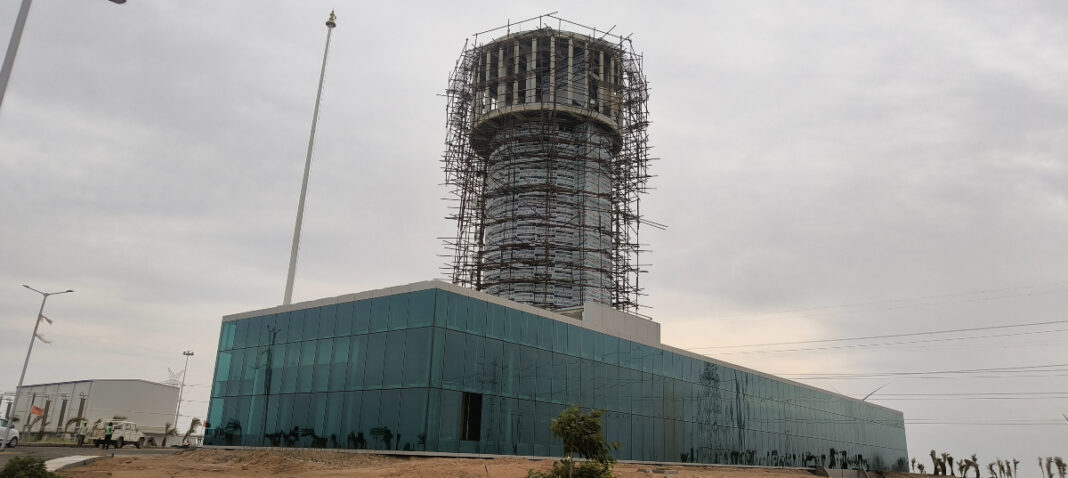Adani Green Energy Limited (AGEL), a global frontrunner in renewable energy solutions, has reached a remarkable milestone as it becomes India’s first ‘das hazari’ (ten thousand) in the renewables sector, boasting a portfolio of over 10,000 MW. Presently, the installed capacity at Khavda stands at 4GW, with plans to elevate it to 30 GW by 2030. This project is poised to become the world’s largest solar park and stands as a testament to AGEL’s prowess in navigating challenging terrains and constructing innovative structures.
At the heart of this project lies the Control Command Centre Building, a critical facility designed for monitoring the entire project and its technological operations. Moreover, it will also oversee defence activities in collaboration with government bodies. Notably, the building features a viewing gallery atop the tower, offering a panoramic perspective of the solar park.
Design challenges
During the initial design phase, various structural options were explored, including Star Columns and Portal Bracings, but ultimately, the decision was made to utilise Tata Structura sections for the project. Thorough comparisons of steel section attributes such as area, bending resistance, buckling capacity, torsion resistance, and symmetry were conducted, leading to the selection of Structura steel sections over I-sections and Star columns.
With a height of 30.9 m, the building is divided into a mezzanine slab and a tower, providing access to the viewing gallery. Situated in seismic zone V, meticulous structural design was necessary to ensure resilience against potential seismic activities.
In the mezzanine area, Tata Structura Tubes provided essential support with their strength in both directions, proving particularly valuable in seismic zone V, where structural integrity is crucial. Despite the generally difficult terrain with more undulations, averaging RL (+) 4.5 m, construction adaptation challenges were successfully addressed.
The design flexibility of Tata Structura tube sections allowed for the elimination of bracings, minimising obstructions within the building and enhancing both aesthetics and functionality. Circular design elements, such as the viewing gallery and circular staircase, added complexity to the structural design.
Strength in structure
The circular tower, housing the viewing gallery, features a top height of 30.9 m, a diameter of 19 m for the top deck, and a lift access circular area of 14 m. Tata Structura steel, with section sizes of 300 x 300 x 10 and 260 x 180 x 8, was extensively utilised, offering the ideal combination of strength and versatility.
A notable design feature is the absence of bracings on the side walls, creating a sleek and modern appearance that complements the glass facade of the building. This aesthetic consideration enhances the overall appeal of the structure, making it visually striking from both interior and exterior perspectives.
Complex splice connections and diamond plates were employed to enhance structural strength and integrity, while inverted V bracing was utilised instead of traditional cross bracing for optimised structural performance. The Mezzanine area covers over 12000 sq m.
Fabrication and erection
Fabrication and construction presented their unique set of challenges for the project. Despite facing adverse weather conditions such as dust storms, soil with poor water absorption capacity, and high wind pressures, the team boldly accepted the challenge and successfully erected the building within the allotted timeline.
The erection process was particularly challenging due to the numerous connections within the building. Extensive discussions and planning were undertaken to reduce the number of connections, streamlining the erection process and improving efficiency.
Erecting the 19 m diameter viewing gallery in a single piece proved to be a daunting task, requiring careful coordination and precision during installation. Additionally, utilising a 150 MT crane for Tower erection presented logistical challenges that needed to be meticulously addressed to ensure safety and efficiency.
The construction of the circular staircase added further complexity to the process, requiring specialised techniques and expertise to integrate seamlessly into the structure while maintaining structural integrity. Despite these challenges, the team persevered, overcoming obstacles to complete the project in a record time of 12 weeks, thanks to the brilliant detailing and application of unique fabrication techniques by the Shree Prefab team.
Quote
“The Khavda project underscores AGEL’s commitment to innovation and sustainability in renewable energy infrastructure. In that, we had to play a big role in providing the best steel infrastructure solution, Overcoming technical hurdles with strategic planning and collaboration.”





